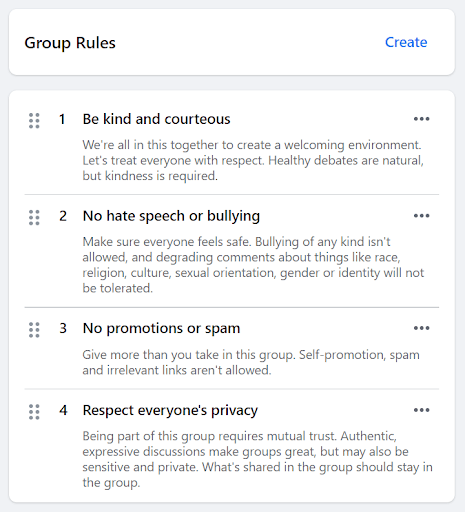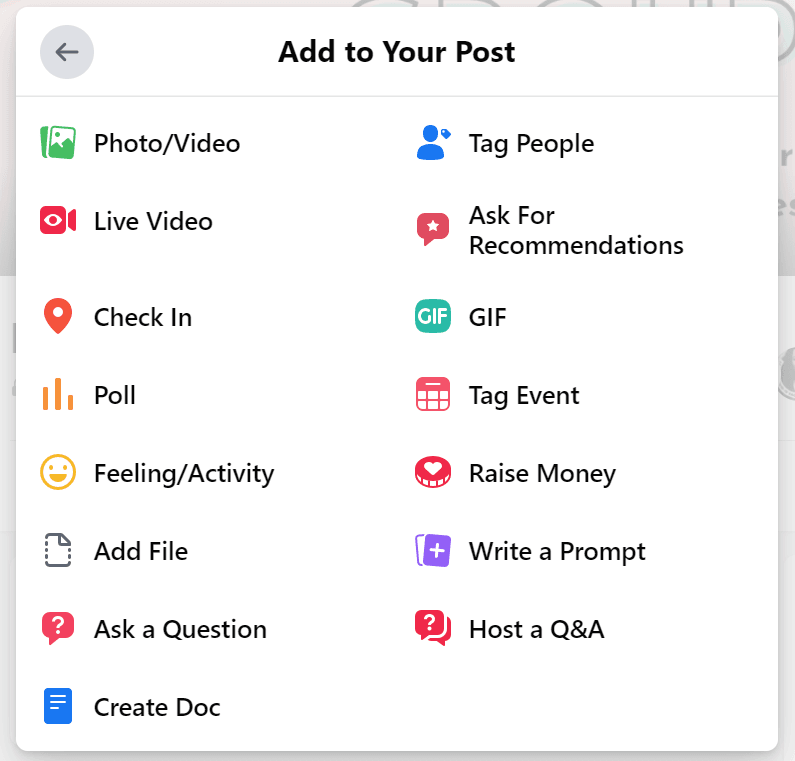Did you know that Facebook has 2.85 billion monthly users?
It’s no wonder it’s one of the top platforms to host a free community for many brands, businesses, and online creators. This is because of the reach Facebook has and the exclusive features such as Facebook groups, where your audience can connect, engage, and communicate with each other.
Facebooks groups have a variety of tools that help brands connect with their audience and community like never before.
With Facebook groups, you can open up a safe space with clear guidelines for your audience to connect, chat, vote on polls, attend live events, and more.
You can even view the group insights and get more information on how to better serve your audience and community.
So how do you get started and run a Facebook group?
How to Create a Facebook Group
You don’t have to be a brand, online creator, or even have a business page to create a Facebook group. Anyone on Facebook can create a group.
If you’re a business and you want the community to be connected to that brand, you must create your Facebook as your business page. If not, you can go ahead and tap the “+” in the top right of Facebook and select Group.
You must decide if you want the group to be public or private and then you can start adding people to your group.
Be sure to keep search keywords in mind when naming your group and adding a description. You want to make it clear who your group is actually for and those people need to be able to find that group and know it’s for them.
For example, if the community is more niche – instead of naming a group “Personal Finance Nerds”, name it “Queer Personal Finance Nerds: Tips and Support of LGBTQ+ in Their Money Story”.
Set Clear Guidelines
Before you start posting and encouraging engagement from the community members, make sure you set clear guidelines for what is and isn’t important.
There are two factors in every successful Facebook group and that is:
- Clear rules
- Moderation
It’s important that you set ground rules, but you also need to enforce them.
Both of these keep the space from going off the rails and becoming a free for all where discussions go off-topic and the group loses focus.
If you need some help creating rules in your Facebook group, they actually provide you with a couple of default ones that are most often used. You can start with these and add custom rules as needed.

How to Run a Facebook Group: Tips for Moderation
After you set the guidelines for the group, you can start inviting people to join, add it to your newsletter, and alert followers on social media.
You can also make it a requirement that when anyone requests to join, they have to acknowledge that they’ve read and accepted the rules.

Even after doing this, I recommend adding an announcement post to make sure the community is aware of the rules. You can even pin it to the top of the discussion tab.
Then as time goes on, make sure you are periodically moderating comments either once a day, once a week, or whatever time period you decide. As your group grows, the commitment to this might also grow exponentially so I recommend maybe having multiple moderators.
Moderators should scan comments and discussion for any violation of the rules and handle accordingly. They should also regularly engage with commenters to drive further engagement.
Tips to Grow Your Facebook Group
Facebook groups are nothing new but they have certainly changed over the years, especially in the way they grow.
When managed properly, Facebook groups have the potential for insane growth. However, there is a right and wrong way to grow a group.
Ways to grow your group ethically and sustainably:
- Offer valuable content
- Encourage independent group discussion
- Use hashtags to add topics for easy organization of content
- Interact with your members and ask questions
- Share the Facebook group link to your newsletter subscribers
- Share the Facebook group link on your website where your audience can easily click and request to join
- Share the Facebook group on your Facebook page to encourage page followers to join
And don’t forget to give people a compelling reason to join. For example: “Look at this interesting discussion going on in our community space. Click here to join 10,000 other queer folks leveling up their financial lives” or something like that. Maybe have a monthly challenge that you host within the group only so then folks are incentivized to join but it isn’t a spammy or monetary incentive to join.
What you want to stay away from:
- Spamming the group
- Allowing spam to continue from group members
- Allowing group members to openly break rules without consequences
- Selling too much to the group and spamming with sales
- Overstretch by trying to do it all yourself
- Add people to the group who didn’t want to join
- Veer off topic too much
If you follow the above tips, you can expect to grow gradually.
Ideas to Increase Engagement and Keep Momentum In The Group
After a group is created, there is a period of heightened engagement and good momentum gets going. What you want to do is not get stuck in a rut of how you manage your group because it can quickly become stagnant and irrelevant.
If your group members catch on to this, they are likely to leave.
Follow these tips to keep your group relevant and constantly growing:
- Regularly run polls for topic discussions, live interviews or sessions they want to see in the group, blog posts, podcast episodes, giveaways, etc so you are letting your group know they are important in their community and they choose what goes on
- Add freebies as files (like maybe a challenge or free checklist)
- Ask questions to the group
- Regularly welcome new members in posts out to the group and give them the chance to introduce themselves
- Create events for the group
- Raise money for a cause the group is interested in or involved in
- Write prompts and keep these consistent (maybe specific prompts on certain days of the week so the group expects it – like sharing weekly wins)
- Continue to switch up using different features in Facebook groups and the group will stay interested – but keep the topics and content consistent

Conclusion: Build Your Successful Facebook Group
Now that you know everything you need to create and start running your successful Facebook group, it’s time to put your plan into action.
Before you jump, make sure that your group has a clear purpose and that your audience wants to use Facebook as their community space. Some folks may have specific privacy concerns so make sure you hear their feedback and act accordingly.
Start with Facebook’s internal help section to answer any questions you have along the creation process and regarding any glitches you might experience.
And as always, start messy and tweak later. Things will be quite bumpy at first but will smooth out as everyone gets a feel for the group and as it grows.















0 Comments